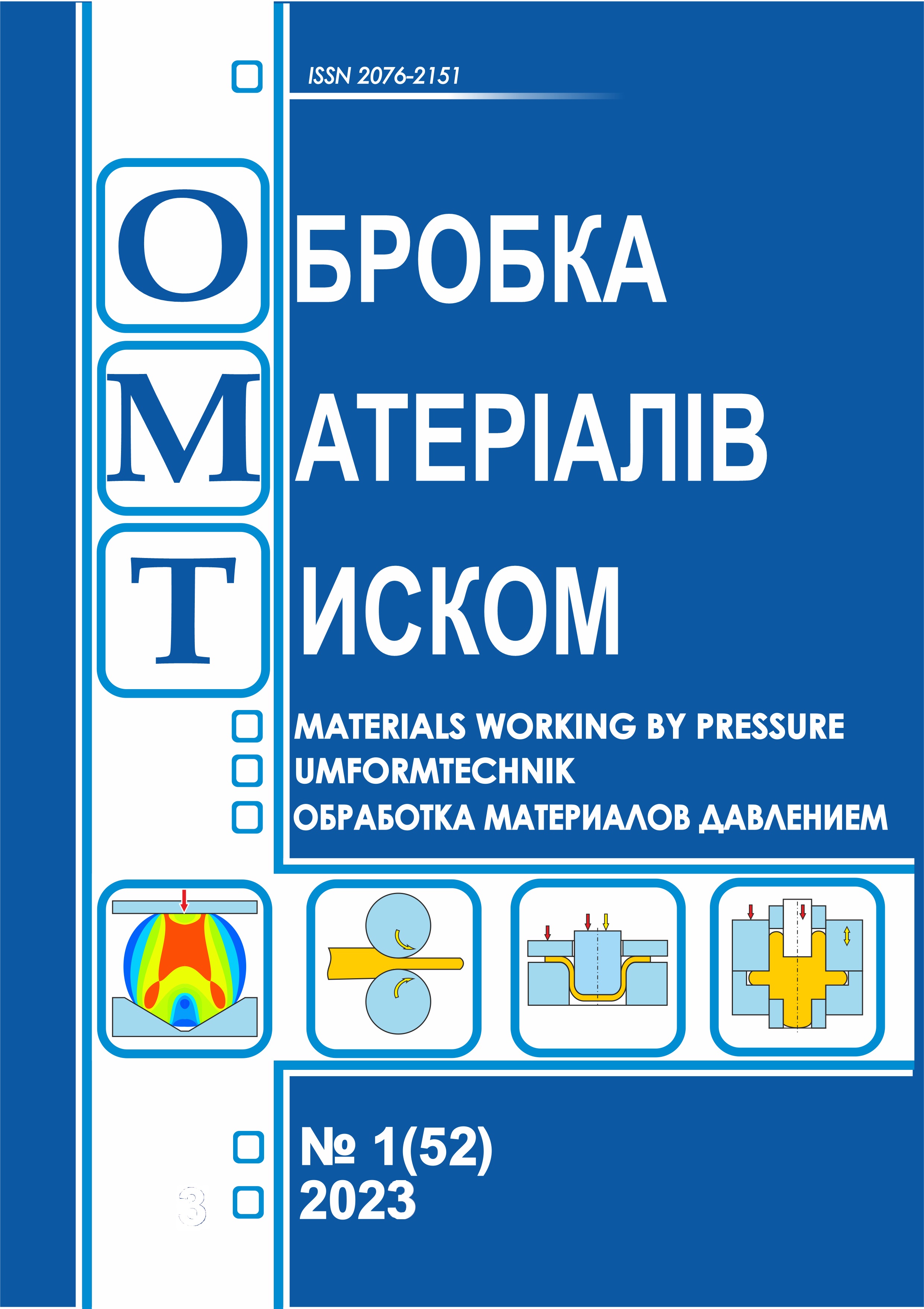Technological properties of core mixtures with phosphates of aluminum, zirconium and silicon for the production of cast blanks of a stamping tool
DOI:
https://doi.org/10.37142/2076-2151/2023-1(52)207Keywords:
die tool, cast blank, core mixture, binder component, gas permeability, compressive strength, tensile strength.Abstract
Liutyi R., Fedorov M., Dyachenko Yu., Kocheshkov A., Demchuk H., Liuta D. Technological properties of core mixtures with phosphates of aluminum, zirconium and silicon for the production of cast blanks of a stamping tool.
In world practice, 70% of die inserts are made by casting methods, while there is a tendency to decrease the use of forgings and graded rolled products. From the point of view of foundry production, the process of obtaining these parts presents a number of difficulties. For their manufacture, medium- and high-alloyed, often complex alloyed steels are used. They predetermine high requirements for thermal and physical-chemical resistance of casting molds. Therefore, the creation of new materials, primarily highly effective binding components for casting molds, is an urgent task. Both the properties of the metal are formed on the basis of its crystal structure, and the properties of the molding (core) mixture are formed at the micro level, as a result of the interaction of the grain base and the films of the binding component with each other. Thus, ensuring the proper level of properties of mixtures for casting cores is a way to ensure the quality of the mold as a whole and the quality of the resulting cast blanks. The article is devoted to the study of properties of core mixtures containing binding components synthesized by original technologies from orthophosphoric acid and a number of additives. Among them are dusty refractory fillers (quartz, zircon, pyrophyllite, disten-sillimanite), as well as aluminum sludge concentrate and aluminum sulfate. The mixtures solidify when heated in the range from 200 to 300 °C. In the work, the strength in compression and at break of the samples of these mixtures was determined, and the relationship between these characteristics was established. The important properties of the proposed mixtures from the point of view of elimination of gas and surface defects of cast blanks are also determined - gas permeability and gas formation. The properties of the studied core mixtures were determined by standard methods and on standard samples accepted for foundry production. The gas-forming ability was determined by an indirect method, by heating samples of mixtures to 1000°C with subsequent fixation of the volume of gaseous substances released from the sample. It has been established that, based on the set of properties, the presented mixtures can be recommended for the production of casting cores in the production of castings from iron-carbon alloys, incl. cast blanks of a stamping tool from alloy steels.
References
Bartel G.P., Fedorov N.N., Tupchienko V.I. A promising technology for the manufacture of wear-resistant cast die tools. Materials of the II International Scientific and Practical Conference “Important machine-building. Problems and prospects for development”. Kramatorsk: DSEA. 2004, pp. 113. (in Russian).
Fedorov G.E., Platonov E.A., M.M. Yamshinsky, R.V. Lyuty. Steel casting: monograph. Kiyv: VIPOL. 2013. 896 p. (in Russian).
Fedorov N.N. Methodological aspects of determining the properties of bentonite molding clays. Casting and Metallurgy. 2014. 4 (77), pp. 19–23. (in Russian).
Fedorov N.N. Additive method of changing the properties of bentonite molding clay. Herald of the Donbass State Engineering Academ. 2010. 3(20), pp. 249 – 253. (in Russian).
Liutyi R.V., Fedorov M.M., Fesenko M.A., Liuta D.V. Regulation of the power of food-clay molding sums with sodium phosphate additives. Naukovi visti NU "Zaporizka Polytechnic". 2023. 2, pp. 38–45. (in Ukrainian).
Ponomarenko O.I., Karateev A.M., Evtushenko N.S., Berezhnaya A.V. The use of OPOS resin in foundry production. Casting Processes. 2010. 6 (84), pp 27 –32. (in Russian).
Karateev A.M., Ponomarenko O.I., Evtushenko N.S., Voskovets V.G., Litvinov D.A. Obtaining high-quality castings based on resin binders // Herald of the Donbass State Engineering Academy. 2010. 3(20). P. 150–153. (in Russian).
Evtushenko N.S., Shinskii O.I., Ponomarenko O.I. Study of the properties of regenerated mixtures based on OFOS // Compressor and Power Engineering. 2013. 4 (34). P. 48-51. (in Russian).
Berlizeva T.V., Ponomarenko O.I., Kachanova N.A. Modeling the properties of CTS based on chromite sand and cyclocarbonates // Compressor and Power Engineering. 2015. 1 (39). P. 48 ... 51. (in Russian).
Usenko R.V., Khrychikov V.E., Seliverstov V.Yu., Mazorchuk V.F. The use of secondary materials in new compositions of iron-phosphate cold-hardening mixtures // Eastern European Journal of Advanced Technologies. 2006. 6/1 (24). P. 40-42. (in Russian).
Selivyorstov V.Yu., Dotsenko Yu.V., Bikova A.S. Investigation of the technological properties of the phosphate molding sums to avenge the high-dispersion ash of TES // Molodiy Vcheniy. 2016. 8 (35). P. 156-161. (in Ukrainian).
Liutyi R.V., Solonenko L.I., Osypenko I.O., Fedorov M.M., Moroz B.I. Physicochemical structure features of refractory compositions with inorganic binders // Physics and Chemistry of Solid State. 2022. 23. 3, pp. 612-619. DOI: https://doi.org/10.15330/pcss.23.3.612-619
Liutyi R., Liuta D., Petryk I. Structural Construction of Binders Based on Orthophosphoric Acid and Refractory Materials // Advances in Materials Science and Engineering. 2021. DOI: https://doi.org/10.1155/2021/6667769
Keush D.V. Patterns of the formation of binders from phosphoric acid and refractory fillers // Casting Processes. 2015. 4 (112). P. 40-46. (in Russian).
Liutyi R., Tyshkovets M., Liuta D. Foundry core mixtures with orthophosphoric acid and different aluminum-containing compounds // Physics and Chemistry of Solid State. 2020. – V. 21. 1, pp. 176-184. DOI: https://doi.org/10.15330/pcss.21.1.176-184
Liutyi R.V., Tyshkovets M.V., Yamshinskij M.M., Selivorstov V. Yu., Ivanov V.G., Synthesis of phosphosulphate substance and properties of its structured mixture with quartz sand // Naukovyi Visnyk Natsionalnoho Hirnychoho Universytetu. 2022. 4. P. 59-65. DOI: https://doi.org/10.33271/nvngu/2022-4/059
Doroshenko S. P. Molding mixtures / S. P. Doroshenko. Kiev : ІZМN. 1997. 140 p. (in Ukrainian).

